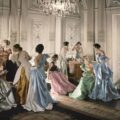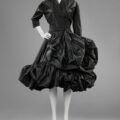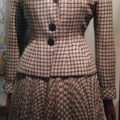Martin Margiela
August 19, 2017Martin Margiela (born 1957 in Genk, Belgium) is one of fashion’s mysteries. He rarely gives interviews, photos of him are few, and there were even several years when most of the fashion world didn’t know whether Maison Martin Margiela still had its eponymous designer at the helm, or not.
The House still sent amazingly avant garde clothing down the catwalk, but who had designed it? Nobody knew. Eventually, in 2009, about six years after the rumours had started, Margiela officially announced his resignation. There was speculation about which designer would replace him, with rumours of approaches to fellow Belgian designer Raf Simons and Haider Ackermann, but in the end the House decided to go on as it probably had been all these years, with the input of a very capable, virtually anonymous team but no big name designer headlining.
Maison martin margiela
Margiela and the Antwerp 6
Martin Margiela graduated from The Academy of Fine Arts in Antwerp in 1979. A year later, the famous “Antwerp 6” – Walter van Beirendonck, Ann Demeulemeester, Dries van Noten, Dirk Van Saene, Dirk Bikkembergs and Marina Yee also graduated from the same place. Together, their unusual approach to fashion lead to a new fashion movement which was more cerebral that much that had gone before. They also collectively showed the fashion world that there was more to see, in more locations, than the holy triumvirate of London, Paris and Milan. The global market place of today was initiated.
After working freelance for a few years, in 1984 Margiela took a job at Jean Paul Gaultier as a design assistant. By 1988 he had founded his own company, Maison Martin Margiela. In 1989 he was awarded the newly set up ANDAM fellowship. It is now known as a prestigious prize and has since been awarded to Viktor and Rolf, Richard Nicoll, Gareth Pugh and Giles Deacon.
Martin Margiela’s first collection provoked an instant reaction.
His work became known for its deconstructed style – darts and seams on the outside, frayed hems, underpinnings visible. Added to this was a play with proportion with long, trailing sleeves and oversized silhouettes. Clothes appear ripped or shredded – most girls showing their legs off in extensively ripped jeans would be surprised to know that they have the avant garde designer to thank for this look.
In 1992 he introduced a high heeled boot with a cloven toe, inspired by Japanese tabi shoes which has become a staple in his collections. He re-works old wigs, gloves, and sliced apart basketball shoes into his collections. Collections may be made entirely from old upholstery fabric, with car seat belts to draw them in, or, in one particularly poetic collection, jewellery made from coloured ice might be allowed to melt on the clothes, leaving brightly coloured stains.
Unusual locations
Margiela chooses unusual locations for his catwalk shows. Models, often with their features masked or obscured, parade on large, round dining tables in a dilapidated warehouse space; in disused subway cars; in the stairwell of a crumbling town house or up and down the steps of an old Routemaster bus. Journalists have been invited to shows not with the traditional gilt edged embossed cards, but with small scraps of paper shoved under hotel doors, which some have confessed the mistakenly threw away.
Martin Margiela chooses to work, not as head designer, although the atelier bears his name, but as part of a collective. Since shortly after the house’s inception, press releases and statements came from the House and not from the designer himself, using “we” and not “I” to describe their thoughts and actions. Any information requests come via fax and not straight from the designer’s mouth – he is actually there backstage at shows but doesn’t come out and take a bow, or speak to the media.
Media shy Martin Margiela
However, although his models might be masked Margiela himself isn’t, and is recognisable backstage and in the showrooms, working tirelessly to prepare the show or excitedly explaining the collection to buyers. He is very excited about his concepts and themes, just rather media shy.
Petit mains
On visiting the work rooms, everybody is dressed in the same white lab coats – these plain white coats are normal attire for the “petit mains” (seamstresses) of a Parisian haute couture house and models wear a modified version as a sort of dressing gown in between fittings, but at Maison Martin Margiela every member of staff wears them.
The shops are dressed the same as the staff – completely in white and with fittings often swathed in white canvas. Martin Margiela’s label is also simple and utilitarian – a small square of white canvas is roughly tacked to the garment using white thread – the four white stitches, showing through to the back, are his trademark. On the label itself is printed, not Maison Martin Margiela but only a number, denoting the collection the garment is from.
Maison Martin Margiela and Diesel
When the label was bought out by the company behind Diesel in 2002, the executives wanted to change all that. They brought out a perfume and started labelling some collections more overtly with Maison Martin Margiela written plainly for all to see. It was dissatisfaction things like this that were rumoured to lead to Margiela distancing himself from his workplace.
In October 2009, Maison Martin Margiela majority stakeholder Renzo Rosso publicly stated that “Martin has not been there for a long time. He is here but not here. We have a new fresh design team on board. We are focusing on young, realistic energy for the future; this is really Margiela for the year 2015.”
Margiela became womenswear director of classic design house Hermes in 1997. It seemed an odd decision, given the designers reputation for shocking clothes, but in fact, classic, wearable tailoring has always underpinned the collections and his work for Hermes was acclaimed as elegant and chic.
John Galliano at maison Margiela
Although Maison Martin Margiela had decided on working collectively, in 2014 this decision was reversed and John Galliano stepped up to take the reins. Galliano had been publicly shunned for several years by then due to an anti-Semitic meltdown he had had in public.
Unlike Margiela he chose to do interviews, and when he appeared in the media talking about the new role, he was both contrite for his former behaviour, and visibly terrified. Fashion commentators were dubious about his ability to pick up the Margiela spirit but after a few lacklustre collections, he seems to have finally found his metier and is now acclaimed for his creative interpretations of the brand’s philosophy.
Martin Margiela
Maison Martin Margiela
Maison Martin Margiela SS11
Margiela 6
Maison Martin Margiela SS11
Maison Martin Margiela SS11
Maison Martin Margiela SS11








![Azzedine Alaïalogo. By alaia.fr (alaia.fr) [Public domain], via Wikimedia Commons](https://www.blue17.co.uk/wp-content/uploads/2017/11/Azzedine_Alaïa__Alaia__corporate_logo-120x120.png)




